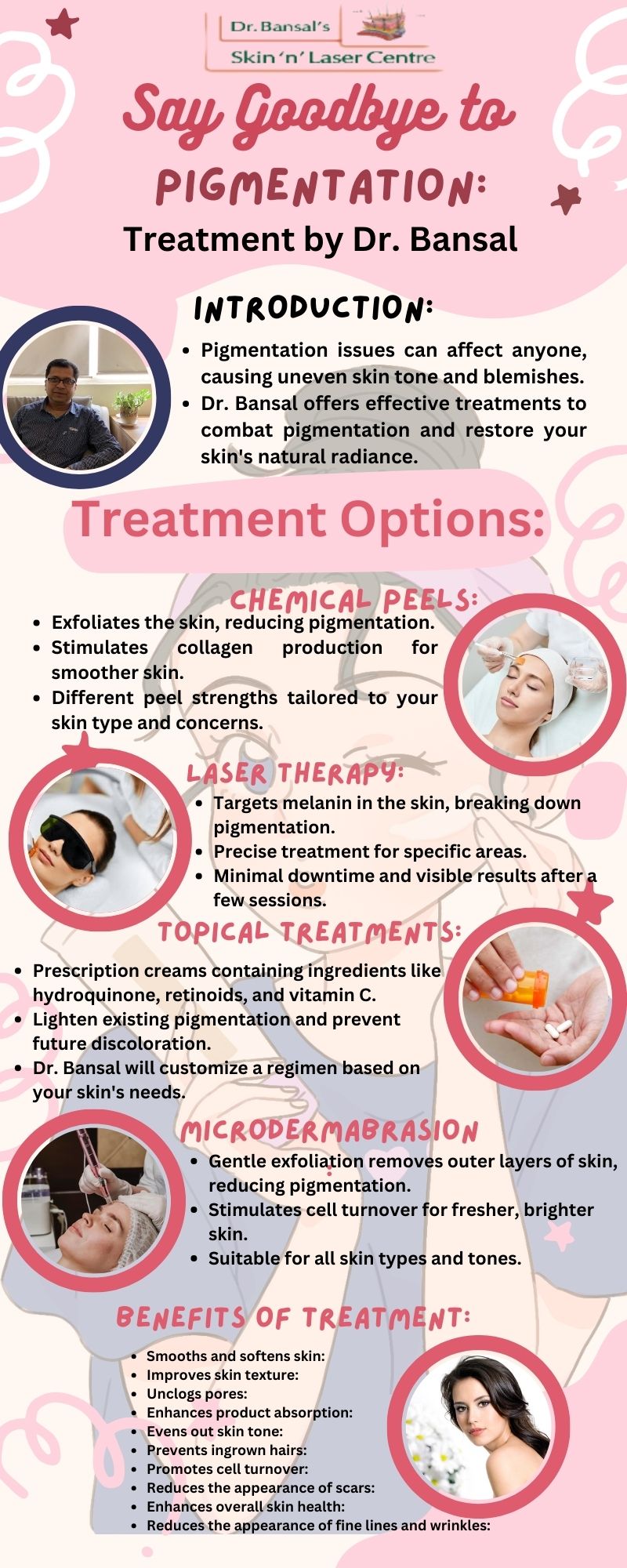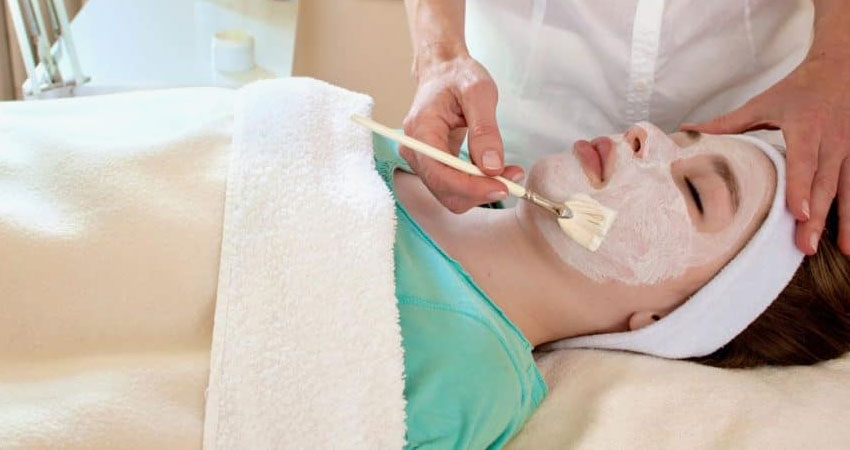Anti Pigmentation Treatment for Radiant Skin
Anti Pigmentation treatment : When it comes to treating pigmentation concerns, it's important to remember that what works best for one person may not work the same for another. However, here are some commonly recommended and effective treatments for pigmentation:
1. Topical Treatments: Various topical treatments can help reduce pigmentation, such as:
- Hydroquinone: A skin-lightening agent that inhibits melanin production.
- Retinoids: These vitamin A derivatives can help exfoliate the skin and fade dark spots over time.
- Vitamin C serums: Antioxidant-rich serums can help brighten the skin and even out pigmentation.
- Kojic acid: Derived from rice or mushrooms, it can help lighten hyperpigmentation.
2. Chemical Peels: Performed by dermatologists or skincare professionals, chemical peels involve applying a solution to the face to exfoliate the outer layer of skin, revealing fresher, more evenly pigmented skin underneath.
3. Laser Therapy: Various laser treatments target pigmentation by breaking down excess melanin in the skin. This includes procedures like laser resurfacing, IPL (Intense Pulsed Light), or Q-switched lasers for specific pigment-related issues, like melasma or sunspots.
4. Microneedling: This procedure involves using tiny needles to create controlled micro-injuries to the skin, stimulating collagen production and helping to fade pigmentation over time.
5. Cryotherapy: In this treatment, liquid nitrogen is used to freeze and destroy hyperpigmented skin cells, leading to lighten pigmentation in the treated area.
6. Prescription Medications: Depending on the severity and type of pigmentation, your dermatologist may prescribe medications like corticosteroids or oral medications to help inhibit melanin production and reduce pigmentation.
Remember to consult a dermatologist or skincare professional to determine the best anti pigmentation treatment in Chandigarh for your specific pigmentation concerns.They will evaluate your skin condition and medical history to provide personalized advice and recommend the most suitable treatment for you. Additionally, it's crucial to maintain a consistent skincare routine with SPF protection and sun avoidance to prevent further pigmentation issues. 
What are the benefits of peeling in anti pigmentation treatment?
Peeling, also known as chemical exfoliation, is a skincare treatment that involves applying a chemical solution to the skin to remove the outermost layer of dead skin cells. Here are some benefits of peeling:
1. Smooths and softens skin: Peeling helps to remove the rough, dead skin cells, leaving your skin feeling smoother and softer.
2. Improves skin texture: By removing the outer layer of dead skin cells, peeling can improve the overall texture of your skin, making it look more even and radiant.
3. Unclogs pores: Peeling can help to unclog pores by removing the buildup of oil, dirt, and dead skin cells that can cause breakouts.
4. Enhances product absorption: By removing the outer layer of dead skin cells, peeling can help your skincare products to absorb more effectively, allowing them to work more efficiently.
5. Reduces the appearance of fine lines and wrinkles: Peeling can help to reduce the appearance of fine lines and wrinkles by stimulating collagen production and improving skin elasticity.
6. Evens out skin tone: Peeling can help to even out skin tone by removing the uneven pigmentation caused by dead skin cells and sun damage.
7. Prevents ingrown hairs: Peeling can help to prevent ingrown hairs by removing the dead skin cells that can trap hair follicles, leading to ingrown hairs.
8. Promotes cell turnover: Peeling promotes cell turnover, which is the process by which old skin cells are replaced with new ones. This helps to keep your skin looking fresh and youthful.
9. Reduces the appearance of scars: Peeling can help to reduce the appearance of scars by removing the dead skin cells that can make scars look more prominent.
10. Enhances overall skin health: By removing the dead skin cells and promoting cell turnover, peeling can enhance overall skin health, leaving your skin looking brighter, more radiant, and more youthful.
Microdermabrasion
Microdermabrasion is a non-invasive cosmetic procedure that exfoliates the outermost layer of the skin using a handheld device. The device sprays tiny crystals or a diamond-tipped wand onto the skin, which gently removes the dead skin cells, revealing a smoother, brighter, and more youthful-looking complexion. Microdermabrasion can help improve the appearance of fine lines, wrinkles, age spots, acne scars, and hyperpigmentation, as well as reduce the size of pores. It is a safe and effective treatment for all skin types and can be performed in a doctor's office, spa, or at home with a handheld device. The results of microdermabrasion are immediate, and multiple treatments may be recommended for optimal results.
Beam laser for micropigmentation
Beam Laser Treat for Micropigmentation is a non-surgical procedure that uses laser technology to remove unwanted pigmentation, such as tattoos or cosmetic pigments, from the skin. This treatment is also known as laser tattoo removal or laser pigmentation removal.
During the procedure, a specialized laser emits pulses of energy that target the ink or pigmentation in the skin. The energy breaks down the pigmentation into smaller particles, which are then absorbed by the body's immune system.
Micropigmentation, on the other hand, is a cosmetic procedure that involves implanting pigment into the skin to create the appearance of hair, eyebrows, or lips. This treatment is often used to enhance or restore facial features, such as in individuals who have undergone chemotherapy or radiation therapy.
Beam Laser Treatment for Micropigmentation is a relatively new application of laser technology that can be used to remove unwanted micropigmentation, such as cosmetic tattoos or implanted pigments that have faded or changed color over time. The treatment works by targeting the pigmentation with laser energy, which breaks it down into smaller particles that are then absorbed by the body.
The benefits of Beam Laser Treatment for Micropigmentation include:
1. Non-surgical: The treatment is non-surgical and does not require any incisions or downtime.
2. Customizable: The treatment can be customized to target specific areas of micropigmentation, allowing for precise and effective removal.
3. Safe: The treatment is safe and has few side effects, such as temporary redness and swelling.
4. Effective: The treatment is highly effective at removing unwanted micropigmentation, with high success rates reported in clinical studies.
5. Versatile: The treatment can be used to remove a variety of micropigmentation, including cosmetic tattoos, implanted pigments, and other types of pigmentation.
Overall, Beam Laser Treatment for Micropigmentation is a safe, effective, and versatile treatment that can help individuals achieve their desired aesthetic results. If you are considering this treatment, it is recommended to consult with a qualified healthcare provider to determine if it is right for you.



